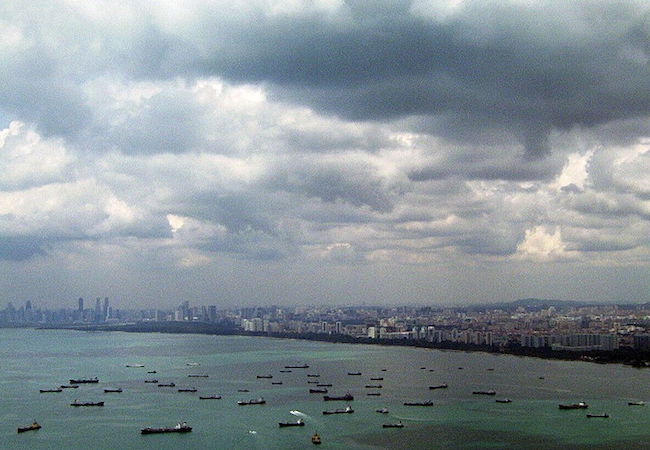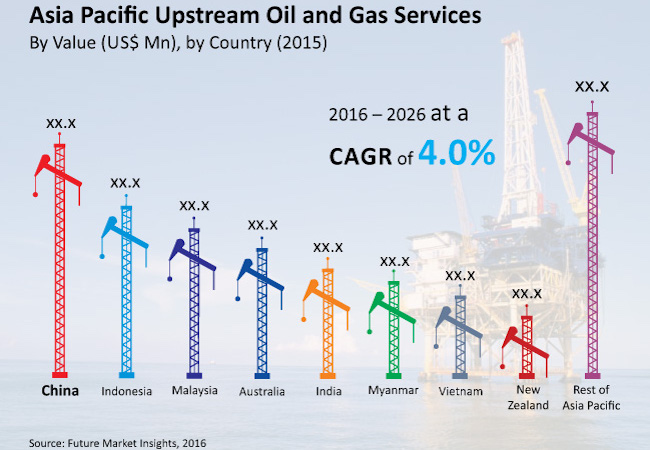
By Siddhesh Asalekar
As global energy corporations continue their hunt for maximizing the planet’s oil reserves in 2017, governments and regulatory bodies in Asia Pacific countries gear up for promoting their upstream oil & gas industry by remodeling trade policies.
This year, the upstream oil & gas services market in Asia Pacific will incur an undulating course of expansion on the account of measures anticipated to be taken by several upstream companies in China, Indonesia, Malaysia and Australia, among others, towards lowering oil prices. The rapidly-extending clout of leading oil & gas corporations invested in the upstream sector of Asia Pacific is slated to permeate through government’s decision-making operations, excerpt favorable dogmas and even compel their steadfast enactment. Over the past few years, upstream oil & gas companies in Asia Pacific countries have encountered major cash crunch when governments stalled the approval of promising projects in the upstream oil & gas industry. In a bid to compensate for their loses during the global dip in oil prices, more projects are likely to be approved across Asia Pacific in 2017, offering a bright side to companies that haven’t backed out from this region.
In 2016, the upstream oil & gas services market in Asia Pacific amassed an estimated US$ 52.6 billion revenues, according to Future Market Insights. The market research firm’s latest study anticipates that Asia Pacific’s upstream oil & gas services revenues will witness a modest increment at 4% CAGR by the end of 2021. The demand for crude oil and hydrocarbons in this region will keep surging on the account of booming industrialization and urbanization in countries such as South Korea, China, India and Australia.
Over the next five years, deep-water exploration measures undertaken by oil companies will be significantly increased across Asia Pacific’s upstream oil & gas industry. Even so, the market is not depicting promising growth in the forecast period. Increased production of shale gas and surplus oil imported to the Americas and European countries from Organization of Petroleum Exporting Countries (OPEC) countries such as Saudi Arabia, Kuwait, Iran and Iraq, among others, are recognized as the two factors limiting the participation of Asia countries in international oil trades. An indeterminate remedial opportunity for Asia Pacific’s upstream oil & gas services market may come in the form of OPEC governments culling their expenditure in energy sector under the clause of “non-essential” spending on oil & gas extraction.
In the coming years, Asia’s oil & gas sector is predicted to add more incentive towards developing upstream business and improving profit margins by employing cheaper feedstock. Indonesia might be at the back ends of developments in Asia Pacific’s upstream oil & gas services, unless Governor Joko Widodo delivers according to his promises of massively reforming deep-sea exploration operations within the country’s maritime boundaries.
Global investments in Asia Pacific’s upstream oil & gas services such as deep-water drilling, exploration of drill wells, recovering raw materials from seabed, employing advanced machineries and extracting chemicals are likely to increase moderately, contingent to the favourable capitalization policies implemented by wealth regulators of the region. Several prominent companies invested in Asia Pacific’s upstream oil & gas businesses such as China National Offshore Oil Corporation or Schlumberger are likely to diversify their upstream businesses, expecting that regional governments act upon their plans to instate gross-split sliding scales as a replacement to the recovery scheme costs for upstream oil & gas services.
New Zealand, Australia, Singapore and Malaysia – essentially identified as Asia Pacific countries – have beguiled the interests of global leaders in upstream oil & gas services for being a part of the Trans-Pacific Partnership (TPP). The pro-corporate, contentious agreement of free trade between the US and eleven of such countries becomes a key growth stimulator for Asia Pacific’s upstream oil & gas services market in the immediate year.

Singapore is primarily known, not as a producer of natural gas or crude oil, but as one of the largest hubs in Asia Pacific for trading equipment & machineries. The demand for upstream oil & gas equipment in Singapore will continue to be aptly met through regulatory advantages availed by equipment manufacturers that enable them to uninterruptedly extend their production capacity. Singapore’s contribution in Asia Pacific’s upstream oil & gas services market will be defined through revenues procured by sales of jack-up rigs, oilfield service equipment, storage & offloading facilities, and floating production equipment in the country. Major offshore upstream oil & gas companies such as Sembcorp Marine are based in Singapore, boosting the country’s presence as a global hub for oil trading & refining. Nevertheless, Singapore’s upstream oil & gas services market is likely to be impaired due to conflicting policies over maritime boundaries among countries from the Association of Southeast Asian Nations (ASEAN). Being a TPP country, Singaporean manufacturers of upstream oil & gas equipment are no longer obligated to include at least 40% of local stocks for receiving preferential tariff rates on their exports to ASEAN countries.
Back in 2014, TPP countries such as Malaysia, Australia, and Indonesia have been recognized as some of the largest exporters of gas (LNG) by the US Energy Information Administration. It has also been reported that average breakeven prices for oil derived from non-sanctioned projects has been the highest in Southeast Asian countries compared to other parts of the world. SapuraKencana Petroleum, one of the largest oilfield service company in Malaysia, is now being identified as owner of the country’s largest tender for upstream oil & gas rigs and equipment. The company has also acquired Petronas’ upstream assets at Vietnam’s offshore fields in 2015, boosting the presence of Malaysia in the Asia-Pacific market for upstream oil & gas services.
The Australian subsea industry, on the other hand, is likely to welcome transformational change in its upstream oil & gas sector ever since oil prices in the country were lowered at the time when the sector shifted from capital intensive construction to operational phase. Meanwhile, China’s upstream oil & gas companies will be recalibrating their global assets if and when the oil prices incur a drastic upsurge. Furthermore, deep-water resource in China’s offshore fields will continue being a profitable & strategic growth opportunity for Beijing’s upstream oil & gas services market. According to a report developed by Future Market Insights, the upstream oil & gas services market in China will amass surplus revenues from the Subsea Umbilicals, Riser & Flowlines (SURF) support services, registering an estimated increment at 6.2% CAGR through 2021.
Over the next five years, companies such as Saipem S.p.A, Transocean Ltd., China Oilfield Services Limited, Schlumberger Limited, Baker Hughes Incorporated, Weatherford, Halliburton, TECHNIP, Flour Corporation, and Petrofac Limited, are expected to be actively participating in the growth of Asia-Pacific’s upstream oil & gas service market.
The insights presented in this article are based on a recent report by Future Market Insights. The excerpts of the report can be browsed at Upstream Oil & Gas Services Market: China to Remain the Dominant Market Through 2021: Asia Pacific Industry Analysis and Opportunity Assessment, 2016-2021
Siddhesh Asalekar is a writer and publisher affiliated with market research firm, Future Market Insights, actively indorsing market studies and industry analysis research developed by the company to share crucial findings and forecast on industrial sectors such as energy and oil & gas.




